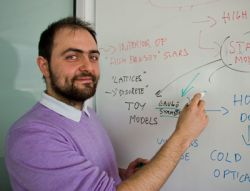
[2013-03-26] Theoretical physicists from Austria and Switzerland aim to solve puzzles in particle physics by simulating them in quantum systems. A research team led by Marcello Dalmonte and Peter Zoller from the Institute of Quantum Optics and Quantum Information in Innsbruck is working on models for the quantum simulation of the so called gauge theories, which will put a completely new perspective on the study of quark-gluon plasma.
The standard model of particle physics describes the elementary particles known in physics and their interactions. Even in the light of the latest experiments at the LHC (Large Hadron Collider) at CERN, this model still holds up. However, many aspects of the model remain unclear. While many challenges of particle physics were formulated in the 1970s, they still haven’t been solved. One of the main reasons is that the methods of classical simulation are insufficient to investigate the complex physical phenomena. “This is where quantum simulation enters the stage,” says Peter Zoller. “The unusual nature of quantum mechanics allows us to solve certain complex problems more easily in quantum systems.” Peter Zoller’s and Marcello Dalmonte’s research team at the Institute for Quantum Optics and Quantum Information (IQOQI) of the Austrian Academy of Sciences (ÖAW) is working on translating certain aspects of the standard model into quantum theory, which will make it accessible for quantum simulation. At the moment they focus on strong interaction, which is one of the four fundamental forces in physics. Strong interaction explains the force that holds quarks together, which, for example, is also the force that binds neutrons and protons together to form the nucleus of an atom.
Quantum Simulakrum
The physicists in Innsbruck work together with particle physicist Uwe-Jens Wiese and his team at the Albert Einstein Institute at the University of Bern to develop theoretical models for the quantum simulation of strong interaction. “Since the standard model is very complex overall, we start by limiting our research to certain aspects of this theory, in particular to gauge symmetry,” says Marcello Dalmonte. “We first translate it into simplified models and then we consider how we could make them accessible for quantum simulation.” In the end they want to find physical models whose quantum simulations can be carried out. “For the simulation we will use ultracold atoms in optical lattices,” says Marcello Dalmonte. “Also arrays of superconducting devices and trapped ions may be considered.”
New perspectives
In big particle accelerators, such as are used at CERN, ions collide with high energy, decay into their components and build quark-gluon plasma. It is the goal of quantum physics theorists to provide tools to better understand these processes in experiments. Mechanisms in neutron stars, for example, could also be explained with quantum simulations. Because of the extremely high density in the deep interior of this type of stars, the nuclei of the atoms can unbind and give rise to quark-gluon plasma or other exotic superconducting states. Again, all attempts of classical simulation fail because of the complexity of the problem. The new approach of the physicists is also important for a better understanding of phenomena in condensed matter, such as super conductors and magnetism.
Fast implementation
In their most recent work, published in the journal Physical Review Letters, the scientists not only describe a model for quantum simulation for gauge theories but also the necessary building blocks for the simulation. “Some of these building blocks could already be implemented in experiments in a few years time,” says junior scientist Marcello Dalmonte. The scientists are supported, among others, by the Austrian Science Fund (FWF) and the European Union.
Venturing into new fields
“Our success is based on the fact that we combine knowledge from different fields,” says the highly decorated Peter Zoller. “Experimentally, we have made huge progress in atomic physics and quantum optics. Also other fields in physics will benefit from it.” It is not the first time that Peter Zoller’s team of researchers has brought new perspectives into physics: He successfully combined quantum optics with quantum information and condensed matter physics. In both cases new independent and dynamic research avenues were opened up. Venturing into particle physics may open doors for yet another promising research field. Apart from Peter Zoller’s research team, other groups of scientists are also studying the same problems: Ignacio Cirac in Munich and Maciej Lewenstein in Barcelona.